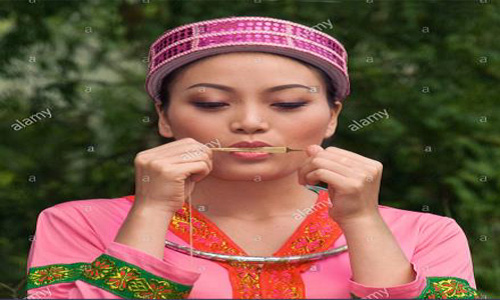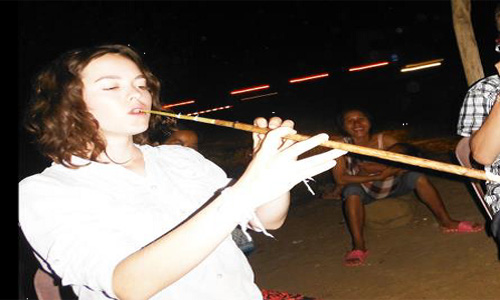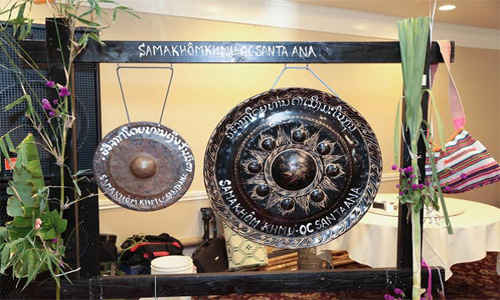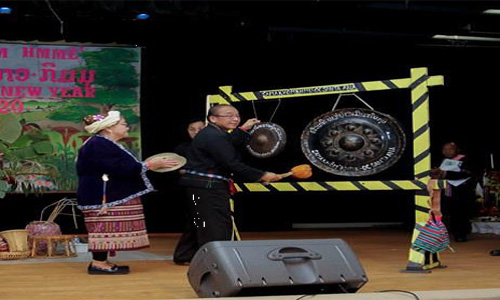The Khmu were the indigenous inhabitants in the northern part of Laos, Thailand, Myanmar (Shan State), Vietnam, and the southern region of China, rich in musical instruments. The musical instruments and forms of this region spring from the same sources: India, the indigenous Mon-Khmer civilizations (Khmu), China, and Indonesia. However from the French colonial period up until the present, some musical instruments gradually disappeared. Khmu musical instruments are mainly made from bamboo, reeds, hardwoods, and simply leaves.
The Khmu (Kamhmu, Kmhmu, Khamhmu) have their own unique traditional instruments that have been taught and passed by elders down to the new generations without written instruction, and no formal documentation about how the types of the instruments, how they are made, used, and played in what occasions. Due to limited regional and personal knowledge, this article will only cover a limited amount of instruments and techniques used in the Khmu culture.
As stated above, most of the traditional Khmu musical instruments are made from bamboo and a few are made from metal, such as bronze or brass. The name of each instrument may be called differently based on the region and the way it is played, based the Khmu regional singing folklores called (Term or Tem). For example, Khmu Xiengkhouang would call (Khène) Swq Kuul where Khmu Luaq Namtha would call it Khène. The following are the Khmu musical instruments that are widely used throughout the Northern Thailand, Laos, and Vietnam: Leaf (Leaf whistling) Puq Hla’, Gong (Rw-baaq), Cymbal (chèèq), Reed Pipe (Pii), Flute (Toot), Khène (sq-kuul), Jaw’s Harp (Hrôôq), and Hand Palm Tapping (Daav-Daav).
LEAF WHISTLING
Leaf whistling, also known as gum leaf instrument, is an ancient musical instrument and it is commonly known and used by many ethnic groups throughout Southeast Asia including the Khmu. It can be picked from of the local trees and played by holding the leaf tightly between the hands and lips, then blowing across the leaf’s surface to create vibrations. Leaf whistling is quick and simple but requires a good technique to produce a sound. It is least known in Western music and not that many Khmu people know how to play it, especially in the newer Khmu generations.
The Khmu often used leaf whistling while they are working in the rice field, hunting, and searching foods in the jungle for communication and/or expression of their happiness feelings.
JAW’S HARP (HRÔÔQ)
Jaw’s Harp is a folk instrument made of bamboo, carved into a long, flat shape with a small sharp tip on one end for lifting and larger angular shape on the opposite end for handheld. It is then cut in the middle, creating a tongue across the hole. There is also a metal variety, which is typically larger and similar to the shape of a leaf. The instrument can be considered either wind or percussion instrument. As a wind instrument, it is placed against the mouth, which acts as a resonator to generate a sound. One may strike the instrument’s tip with the thump by either lifting it or lowering it to allow the instrument’s tongue to vibrate. When the Jaw’s Harp’s tongue is made to vibrate, a buzzing is created, imitating words by musician’s tongue, which can later be translated and understood by the listeners.

This instrument was widely used as a means of communication between dating couples sneaking during the night. Separated by just a bamboo wall, the male will communicate with female in her house, while the male sits outside, both using the Jaw’s Harp. The Jaw’s Harp instrument is no longer used by the newer Khmu generations. Today, only a few elders, living in the rural areas, can play this instrument.
FLUTES – (PII)
The flute is a family of musical instruments in the woodwind group. According to the instrument classification of Hornbostel–Sachs, flutes are categorized as edge-blown aerophones. Unlike typical woodwind instruments with reeds, a flute is reedless wind instrument that produces its sound from the flow of air across an opening that controls by fingers to generate different tones.

There are numerous types of bamboo flutes made by the Khmu people, such as mouth flute (Pii) and nose flute. The mouth flute (Pii) comes in two-three variations. One type is made of small bamboo using four or five sections with the bigger and longer section at one end, and becomes smaller and shorter towards the other end and small hole is made at the tip for the musician to blow air through to create the sound. Four holes are drilled into the middle sections for fingers to control and change the tone. And the other type is made from one section of small bamboo with a small strip hole for blowing and three or four holes drilled in mid-section approximately 3 to 4 inches apart for fingers to change the pitch. These types of flutes are played vertically.
Each Khmu region plays the flute slightly different, based on their regional singing folklore called (Term or Tem). Generally it is played by men during small gatherings accompanied by a folklore singer (Term). Occasionally, it can be played alone in the evening or early in the morning to express the musician’s happiness.
NOSE FLUTE – (TOOD or TOD)
The nose flute (Tood Muh) is normally played by women in the remote rural places, where elders still remember their traditional music and singing techniques. The Khmu people living in the cities and the newer Khmu generations that have assimilated with the Lao ways would not have the knowledge to play this instrument.
It is a bamboo tube with three holes, two holes for fingers to change the sound and one hole for blowing. There is also another variation of the nose flute (Tood) that has three equidistant holes, the middle hole is for blowing by either mouth or nose and the other two holes on each end are for fingers to control sound. Thus, this nose flute can play notes in a range of two and a half octaves. Finger holes in the side of the bamboo tube change the operating length, giving various scales. Players plug the other nostril to increase the force of their breath through the flute.
The Khmu people, living in the rural valley, often played the flutes while working in the rice field, coming home from the rice field, or searching for food in the jungle such as mushroom, vegetables, and bamboo shoots. With a jungle abundant in bamboo, this instrument can be easily made on the spot.
PALM TAPPING – (Daav Daav)
The palm tapping called (daav daav) in Khmu is a musical instrument that made from a fresh bamboo tube about 2 to 3 inches in diameter and 2 to 3 feet in length. It is then cut open on both sides of the tube, leaving two strips about 1-1/2 in width and 12-14 inches in length for tapping. When tapping at the mid-section of the tube on the palm of the hand, the strips vibrate and generate echoing sound from the bottom of the hollow tube.
Originally, this instrument (dao-dao) was used as entertainment by the women while the men are clearing a field in the jungle, to be used for plantation. Additionally, this instrument also used as entertainment during the Khmu New Year celebration.
Khène – (Sq-kuul or Swq Kuul)
This musical instrument called Khène or Khaen (Sq-kuul) is the Laotian national instrument and the oldest musical instrument used in Laos, originating from the Lanxang period.
Khène (Sq-kuul) is typically an eighty-ninety centimeter (roughly 31.5 to 35.4 inch) long mouth organ constructed of seven or eight pairs of bamboo with reed, connected with a small, hollowed-out hardwood reservoir into which the air is blown. Its sound is similar to that of a violin, and it may be played as a solo instrument or to accompany singers and instrumental ensembles. The khène can also be made in a two meter (approximately six and a half foot) version. Very few musicians have powerful enough lungs to master this variation.
The khène (sq-kuul) is widely used and played by many regions in Laos, Thailand, and Cambodia. The Khmu also played the khène (Sq-kuul) as entertainment in weddings, ritual ceremonies (tèèq môn), social gatherings, and (Greh) New Year celebrations. Additionally, it can also be played for just personal entertainment, for fun.
The Khmu men usually play this instrument alongside singer(s), which can either be a man or woman, or both take turn singing (tem or term) to each other. These practices can be seen at the Khmu New Year celebrations, weddings, and annual ritual ceremonies (tèèq môn). At these events, a jar of rice wine is often provided for drinking and honoring guests.
Nipple or Knobbed Gong – (Rw Baaq)
A gong is an East and Southeast Asian musical percussion instrument that takes the form of a flat, circular metal disc which is hit with a mallet. The origin of gong is believed to be from China. Gong comes in various designs, such as flat surface without nipples and with nipples. A nipple gong has a center raised boss or nipple. Nipple gongs are known for a pure resonant tone with less shimmer than other gongs. They can produce many distinct sounds due to their shape when struck by a mallet which is a wooden stick wrapped with pads and cloths.

The Khmu usually used the gongs for New Year celebrations, ritual ceremonies (tèèq môn), new rice festivals, and agricultural rituals. Additionally, the nipple gongs are used for the Khmu New Year celebration parade and Phon Nang Keo dance performance. Cymbals and bamboo sticks are typically used to maintain a constant rhythm during the performance. The gong is also used as a signaling instrument to accompany dances and performances at the New Year celebration. Khmu people in some regions believed that gongs and cymbals have a magic power of dispelling evil or bad spirits, therefore, they often used these instruments for their ritual ceremony and funeral services.
Cymbals – (Chèèq)
Cymbals are indigenous to Asia and are made from copper and nickel alloys. They have a unique form, concave, funnel-shaped on one side and convex bowl-out on the opposite side like woman nipple with a long string serving as handles. Cymbals were the only permanent idiophones of the Temple orchestra. When the two cymbals crashed into each other, they produce a bright, crisp, and explosive tone. The origin of cymbals is believed to be from China as well as the gong, and it is widely used throughout Asia.

Typically, the Khmu people used cymbals to accompany gongs for the New Year parades, Greh celebrations, annual ritual ceremonies (tèèq môn), new rice festivals, and agricultural rituals. Furthermore, in some parts of Southeast Asia their ancient belief of dispelling evil spirits. Therefore, the Khmu used gongs and cymbals for ritual blessings or calling upon good spirits for a sick individual (pua hm-maal rw kw-eey hm-maal) and funeral services. During a funeral service, the cymbals will be used along with gong when the dead body is carried out of the house to ensure the evil spirits do not linger behind.
Written By: Steve Sengaroun
Reference sources:
www.britannica.com/art/Southeast-Asian-arts
www.wikimedia.org/wiki/Category:Khmu_musical_instruments
www.kinkgong.bandcamp.com/album/gongs